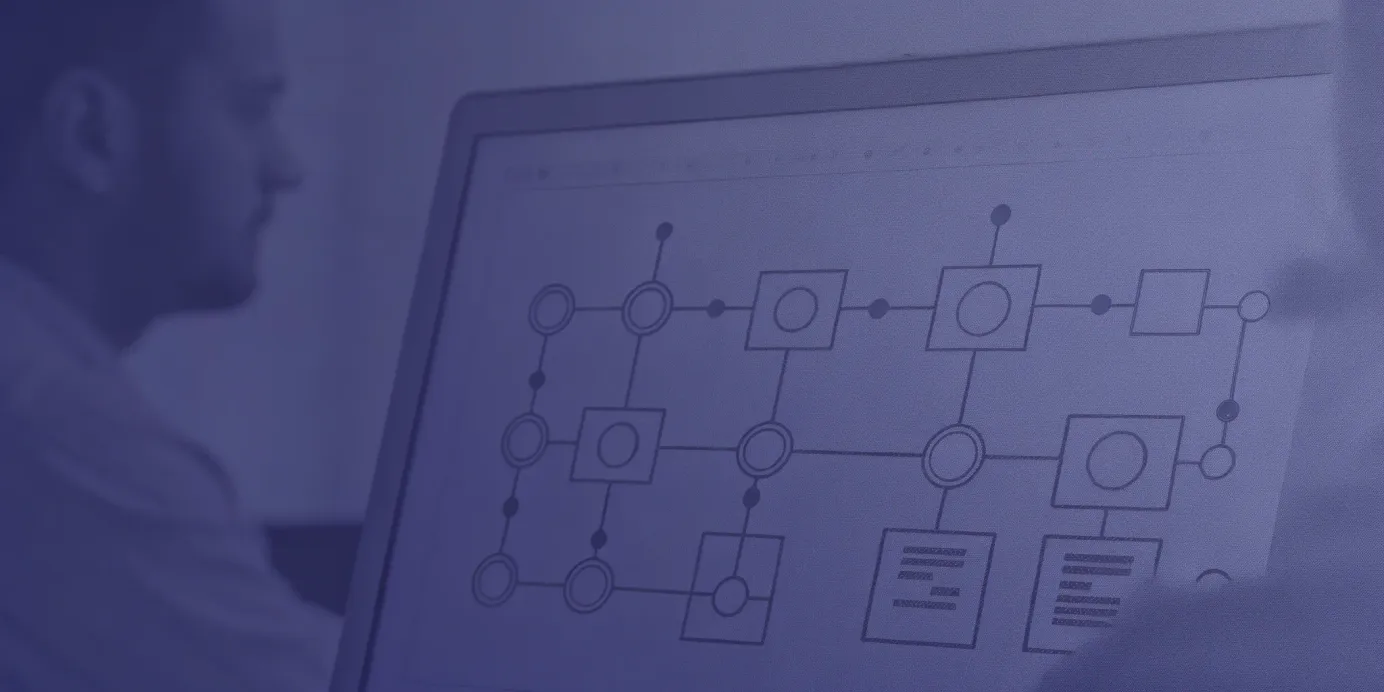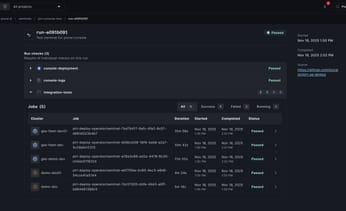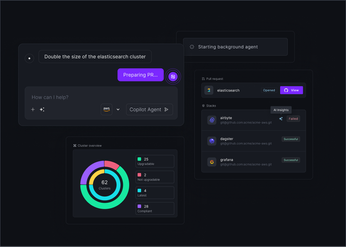
Kubernetes Enterprise Support: The Ultimate Guide
Get expert insights on kubernetes enterprise support, including key features, benefits, and how to choose the right provider for your organization.
The promise of Kubernetes is agility at scale, but in practice, many teams face heavy operational overhead. Engineers lose time managing sprawling YAML files, debugging misconfigured network policies, and manually applying security patches across clusters. These challenges slow delivery, increase costs, and introduce unnecessary downtime risks. A strong enterprise Kubernetes support strategy helps eliminate this overhead. With automated, GitOps-driven workflows and centralized management, support platforms reduce firefighting and ensure consistent operations. Instead of chasing cluster issues, your team can focus on building and shipping features that drive value.
Unified Cloud Orchestration for Kubernetes
Manage Kubernetes at scale through a single, enterprise-ready platform.
Key takeaways:
- Treat enterprise support as a strategic platform: Shift your thinking from break-fix assistance to a comprehensive solution. Enterprise support provides the integrated security, observability, and lifecycle management needed to transform Kubernetes into a stable, production-ready system for your most important applications.
- Unify fleet operations with a GitOps workflow: The most effective way to manage multiple clusters is through a centralized, GitOps-driven approach. A unified platform like Plural automates deployments and enforces consistent configurations, eliminating operational silos and reducing the risk of human error at scale.
- Prioritize security and automation from the start: A secure Kubernetes environment is built, not bolted on. Implement robust access controls, network policies, and automated compliance checks from day one to create a defensible, auditable, and maintainable platform for the long term.
What Is Enterprise Kubernetes Support?
Enterprise Kubernetes support goes beyond break-fix help. It delivers a hardened, production-ready distribution of Kubernetes bundled with the tooling and services required to run at scale. In practice, this means guardrails for security, automation for day-2 operations, and expert guidance for critical workloads. Instead of forcing your engineers to become Kubernetes experts, enterprise support turns the raw open-source project into a complete, enterprise-grade platform for building and running containerized applications.
Platforms like Plural exemplify this approach by offering a unified cloud orchestrator—providing a single pane of glass to manage your entire Kubernetes fleet. This simplifies operations and enforces consistency across all clusters.
What’s Included in an Enterprise Plan?
An enterprise plan typically bundles:
- Security & Compliance: Vulnerability scanning, policy enforcement, and hardened configurations.
- Stability & Performance: Curated patches, long-term support, and SLA-backed availability.
- Pre-Vetted Integrations: Networking, storage, monitoring, and logging baked in—saving teams months of integration work.
- Developer Experience: CI/CD pipelines, self-service environments, and curated templates to accelerate delivery.
Together, these components create a cohesive, production-ready ecosystem instead of a DIY toolkit.
How It Differs from Standard Support
Open-source Kubernetes is flexible but fragmented—you assemble everything yourself, from networking to observability. Support comes primarily from community forums and docs, which are insufficient for mission-critical systems.
Enterprise support, by contrast, provides:
- A validated, integrated stack with proven defaults.
- One throat to choke: a single vendor for support and accountability.
- Reduced operational risk and faster time to production.
For many organizations, this difference determines whether Kubernetes is a liability or a growth enabler.
Breaking Down Service Tiers
Enterprise support is usually offered in tiers:
- Basic: 24/7 technical support, knowledge base, and incident response.
- Mid-Tier: Proactive monitoring, performance tuning, architectural reviews.
- Premium / Fully Managed: Provider handles everything—cluster provisioning, upgrades, patching, and security management.
Your choice depends on internal expertise, compliance needs, and how much operational burden you want to offload.
Key Features of Enterprise Support
Enterprise support is more than a helpline; it’s a comprehensive suite of tools, services, and expertise designed to address the operational realities of running Kubernetes at scale. While standard Kubernetes provides the core engine, enterprise support delivers the robust chassis, advanced navigation system, and expert pit crew required to operate successfully. It transforms Kubernetes from a powerful but complex open-source project into a stable, secure, and manageable platform ready for business-critical applications. The key features included in these support packages directly target the most significant challenges teams face, from securing clusters and maintaining compliance to simplifying daily operations and managing costs.
These features typically fall into several core categories: robust security tooling, unified observability, end-to-end lifecycle management, team enablement, and expert technical assistance. For example, instead of manually patching vulnerabilities across dozens of clusters, an enterprise platform automates the process. Instead of piecing together monitoring tools, it offers a unified dashboard. By integrating these capabilities, enterprise support provides a holistic solution for managing the entire Kubernetes ecosystem. This approach not only reduces operational overhead but also allows engineering teams to focus on delivering value instead of constantly fighting fires within their infrastructure.
Security and Compliance Tooling
Enterprise Kubernetes platforms are designed to be secure by default. They provide "hardened" environments with features that go beyond standard installations, such as enhanced encryption and tools to enforce security policies across all clusters. This is critical for organizations in regulated industries that must adhere to standards like FIPS 140-2 or SOC 2. An enterprise solution helps you implement consistent security controls and automate compliance checks, reducing the risk of misconfigurations that could lead to vulnerabilities. Plural, for example, integrates with OPA Gatekeeper for policy enforcement and automates cluster updates to ensure security patches are applied promptly, helping you maintain a strong security posture across your entire fleet.
Centralized Monitoring and Observability
Managing a single Kubernetes cluster is complex; managing a fleet is nearly impossible without a unified view. Enterprise support provides centralized monitoring and observability, consolidating logs, metrics, and traces from all your clusters into a single interface. This eliminates the need to switch between different tools and contexts when troubleshooting. A lack of observability is a common Kubernetes challenge that can lead to prolonged downtime. Plural addresses this directly with its single-pane-of-glass console, which includes an embedded Kubernetes dashboard. This gives teams secure, SSO-integrated access to view workloads and diagnose issues without juggling kubeconfigs or complex network configurations, providing a clear line of sight into the health of your entire environment.
Full Application Lifecycle Management
Enterprise support extends beyond the cluster itself to encompass the entire lifecycle of the applications running on it. This includes everything from initial deployment and configuration to ongoing updates and scaling. A true enterprise platform provides full support for running containers, not just orchestrating them. It offers integrated tooling for continuous deployment, infrastructure management, and automation. Plural’s platform embodies this with its GitOps-based continuous deployment for syncing manifests, API-driven infrastructure management via Plural Stacks for Terraform, and self-service code generation. These features create a repeatable, scalable workflow for managing applications from development through production, reducing manual effort and ensuring consistency.
Team Training and Documentation
The steep learning curve of Kubernetes is a significant barrier to adoption and effective management. Enterprise support helps bridge this knowledge gap by providing comprehensive documentation, best practice guides, and access to training resources. This empowers your entire engineering team, reducing the dependency on a small number of senior Kubernetes experts. By focusing on developer experience and providing clear operational procedures, these support offerings make it easier for junior engineers to contribute effectively. Plural’s design philosophy centers on simplifying complexity, with streamlined workflows and an intuitive UI that lowers the barrier to entry for managing a sophisticated Kubernetes environment at scale.
24/7 Technical Support
When critical systems fail, you need immediate access to expert help. A core component of any enterprise support package is 24/7 technical assistance from engineers who specialize in Kubernetes. This is more than a simple helpdesk; it’s a direct line to a team that can help diagnose complex issues related to networking, storage, security, or application performance. Having this level of expert support on standby is essential for minimizing downtime and ensuring business continuity. It acts as a safety net, giving your internal teams the confidence to manage production workloads. Plural’s enterprise plans include this level of dedicated support, ensuring you can resolve critical issues promptly with help from a team that knows your environment.
Solving Common Enterprise Challenges
Enterprise Kubernetes adoption introduces a unique set of operational hurdles that can slow down teams and increase risk if left unaddressed. From managing dozens of clusters to enforcing consistent security policies, the complexity can quickly become overwhelming. A robust enterprise support strategy, backed by the right platform, is essential for turning these challenges into manageable, automated workflows. By centralizing control and standardizing processes, organizations can leverage the full potential of Kubernetes without succumbing to its operational overhead.
Managing Multiple Clusters
As Kubernetes adoption grows within an organization, teams often create their own clusters with distinct tooling and deployment methods. This fragmentation leads to operational silos and inconsistencies that are difficult to manage at scale. Without a unified approach, enforcing security standards, tracking costs, and troubleshooting issues across the fleet becomes a significant burden. Plural addresses this by providing a single pane of glass for your entire Kubernetes fleet. Its agent-based architecture allows you to securely manage clusters across any cloud or on-prem environment from a centralized control plane. This ensures every team operates with a consistent, GitOps-driven workflow, simplifying management and improving visibility.
Simplifying Complex Configurations
Kubernetes relies on detailed YAML files for configuration, where even minor errors can cause deployment failures or application downtime. As environments scale, the complexity of managing these configurations grows exponentially, making manual validation and debugging unsustainable. Teams often struggle with the steep learning curve and the high potential for human error. Plural mitigates this challenge with API-driven infrastructure management. By treating infrastructure as code with tools like Terraform integrated into a Kubernetes-native workflow, you can automate configuration changes reliably. This approach reduces the risk of misconfiguration, provides version control for your infrastructure, and allows teams to deploy complex applications with confidence.
Implementing Security Policies
Enforcing consistent security policies across a distributed fleet of Kubernetes clusters is a critical but challenging task. Manually configuring Role-Based Access Control (RBAC), network policies, and other security settings for each cluster is inefficient and prone to error, creating potential vulnerabilities. An enterprise platform must provide a way to implement security at scale. Plural enables you to define and distribute security configurations using a centralized GitOps workflow. You can create global services that sync standardized RBAC policies to every cluster in your fleet, ensuring that access controls are uniform and aligned with your organization’s compliance requirements.
Handling Custom Integrations
A production-ready Kubernetes environment relies on a wide range of integrations with open-source tools for monitoring, logging, security, and automation. Managing the lifecycle of these tools—including installation, configuration, and updates—across multiple clusters adds another layer of complexity for platform teams. Plural simplifies this with its integrated open-source marketplace. It offers pre-vetted, one-click deployments for essential applications like Prometheus, Grafana, and Airflow. This ensures your clusters are equipped with a consistent and reliable toolchain from the start, reducing the operational overhead required to maintain custom integrations and allowing your team to focus on core business logic.
Optimizing Performance and Cost
While Kubernetes offers powerful autoscaling capabilities, it doesn’t automatically optimize for cost. Without clear visibility into resource consumption, organizations often over-provision resources, leading to significant wasted cloud spend. To truly optimize, you need detailed insights into how your applications are performing across the entire fleet. Plural’s centralized dashboard offers a unified view of resource usage, helping you identify and eliminate waste. By combining this visibility with automated, GitOps-driven deployments, you can enforce resource limits and requests consistently, ensuring your applications scale efficiently while keeping costs under control.
Why Your Organization Needs Enterprise Support
As Kubernetes adoption shifts from side projects to core infrastructure, professional support becomes essential. Vanilla Kubernetes offers the primitives, but it doesn’t provide the guardrails, security assurances, or operational controls needed to run production-grade clusters at scale. Enterprise support bridges this gap by standardizing operations, enforcing security and compliance, and reducing technical debt. Instead of firefighting misconfigurations or outages, teams can manage Kubernetes strategically, with predictable processes that scale.
Manage Complex Deployments at Scale
Kubernetes adoption often grows organically, with teams building their own CI/CD pipelines and deployment workflows. While this works early on, it creates fragmented environments that are hard to govern and nearly impossible to standardize. Configuration drift, inconsistent tooling, and duplicated effort follow.
Enterprise support addresses this by enforcing a consistent, GitOps-driven model (see Argo CD or Flux ). With a unified control plane, every team follows the same workflow for deploying workloads and managing infrastructure, reducing operational overhead while improving reliability.
Meet Security and Compliance Mandates
Enterprises face strict compliance requirements—SOC 2, HIPAA, FedRAMP—that are difficult to meet in a fast-moving Kubernetes environment. Common missteps like overly broad RBAC roles or insecure network policies often expose clusters to risk.
Enterprise-grade platforms simplify compliance with centralized security enforcement. Fleet-wide RBAC policies, identity-based access management, and auditable change histories ensure consistent policy application across clusters. This not only improves security posture but also reduces audit burden.
Optimize Resource Usage
Kubernetes can autoscale applications on demand, but without governance, this flexibility often leads to over-provisioning and higher cloud spend. Teams frequently “play it safe” by requesting excess CPU/memory, masking inefficiencies.
Enterprise support provides cluster-wide observability (via tools like Prometheus , Grafana , or commercial APMs) to identify underutilized resources and right-size workloads. With clear usage data, teams can fine-tune requests and limits, cutting waste while ensuring applications remain performant.
Scale Operations with Confidence
Scaling Kubernetes isn’t just about adding clusters—it’s about ensuring consistency, security, and developer productivity as you grow. Without a repeatable architecture, complexity multiplies and slows down delivery.
Enterprise support provides an opinionated foundation: secure control planes, API-driven workflows, and automated infrastructure management. This enables teams to deploy faster with fewer errors, while platform engineers maintain consistency across environments.
Reduce Long-Term Technical Debt
Technical debt in Kubernetes often stems from ad-hoc scripts, inconsistent manifests, and manual workarounds. Over time, this fragility slows down delivery and increases outage risk.
Enterprise-grade support enforces best practices from the start. With GitOps workflows and infrastructure as code, every change is version-controlled, auditable, and reproducible. This reduces manual interventions, prevents drift, and establishes a maintainable, future-proof Kubernetes foundation.
How to Choose a Support Provider
Choosing the right enterprise Kubernetes support provider directly impacts your stability, security, and scalability. The market is crowded with options—from cloud-native services like EKS Anywhere, GKE Enterprise, and AKS Enterprise to independent third-party platforms. The right partner should do more than fix issues: they should help you optimize operations, reduce downtime, and accelerate delivery.
When evaluating providers, focus on:
- Technical expertise aligned with your stack.
- Service Level Agreements (SLAs) with clear, enforceable terms.
- Support model (availability, response times, escalation paths).
- Integration capabilities with your existing toolchain.
- Impact on Total Cost of Ownership (TCO), not just subscription price.
A provider that doesn’t fit can increase friction and costs, while the right one becomes a strategic extension of your engineering team.
Assess Their Technical Expertise
Kubernetes deployments rarely look the same across organizations. A good provider should adapt to your workflows, not force you into theirs. Look for hands-on experience across:
- Infrastructure-as-Code (e.g., Terraform)
- CI/CD systems (e.g., Jenkins)
- Service mesh technologies (e.g., Istio)
They should be able to debug across the full stack—from underlying cloud infrastructure to application pods. Some platforms, like Plural, emphasize native IaC workflows to handle the Terraform sprawl common in enterprise Kubernetes.
Understand the Service Level Agreement (SLA)
An SLA defines the provider’s guarantees on uptime, response times, and resolution. Strong SLAs have:
- Tiered response times (e.g., <15 minutes for production outages).
- Clear escalation paths.
- Penalties or credits if terms aren’t met.
Vague commitments like “best effort” are a red flag. A detailed SLA holds your provider accountable and ensures Kubernetes stability translates into real-world reliability.
Check Support Coverage and Availability
Enterprise workloads run 24/7, and your provider’s coverage should match. Key questions:
- Do they provide follow-the-sun support with engineers across time zones?
- Are there real-time channels (phone, Slack/Teams, chat) for critical issues, or only ticket queues?
- Do they offer proactive reviews (architecture, security, scaling), or just reactive fixes?
The best providers partner in your long-term success by preventing issues before they happen.
Verify Integration Capabilities
Kubernetes relies on an ecosystem of tools for observability, security, and automation. Your provider must integrate with what you already use—whether it’s Prometheus for metrics, OPA Gatekeeper for policy, or ArgoCD for GitOps.
A provider with strong integration support helps avoid lock-in and lets you continue leveraging best-in-class tools. Platforms like Plural emphasize working with your Git repos and identity providers instead of forcing new workflows.
Analyze the Total Cost of Ownership
Subscription fees are only part of the equation. Real costs include:
- Resource optimization – tuning autoscaling and utilization can cut cloud bills.
- Operational savings – reducing time spent firefighting frees engineers for product work.
- Downtime reduction – better SLAs and proactive support prevent expensive outages.
The right provider should help optimize both direct infrastructure spend and indirect costs tied to developer productivity.
A Practical Implementation Plan
Adopting or scaling Kubernetes across an enterprise requires more than just technical execution; it demands a structured, strategic approach. A well-defined implementation plan ensures that your transition is smooth, your teams are prepared, and your architecture is built for long-term stability and security. This plan acts as your roadmap, guiding you from initial evaluation to a fully operational, secure, and maintainable enterprise Kubernetes environment. The following steps outline a practical framework for getting there, focusing on assessment, strategy, training, and establishing robust operational procedures from day one.
Start with an Initial Assessment
Before migrating workloads or standardizing your environment, you must understand the current state of your infrastructure and applications. In many organizations, individual teams adopt Kubernetes independently, resulting in disparate tooling, cluster management methods, and deployment pipelines. A thorough initial assessment involves cataloging every application, its dependencies, and its current hosting environment. You should also evaluate the existing skill sets within your engineering teams to identify knowledge gaps. This audit provides a clear baseline, highlighting inconsistencies and risks that need to be addressed. It helps you understand the scope of the challenge and forms the foundation for a realistic migration strategy.
Create a Clear Migration Strategy
With a complete assessment, you can build a well-defined migration strategy. This is not just a technical plan but a business-aligned roadmap for moving applications to your standardized Kubernetes platform. A good strategy prioritizes applications based on complexity and business impact—often starting with stateless, non-critical services to build momentum and learn lessons in a lower-risk setting. Your strategy should also define clear success metrics, such as improved deployment frequency, reduced operational overhead, or enhanced scalability. Using a platform that supports infrastructure as code can make this process repeatable and less error-prone, allowing you to codify your infrastructure patterns and apply them consistently across every migration.
Train Your Engineering Teams
Kubernetes has a steep learning curve, and a lack of expertise can quickly become a bottleneck. Training is a critical component of any successful adoption. Ensure your engineering teams are well-versed in Kubernetes fundamentals and best practices to facilitate smoother operations and reduce reliance on a small group of senior experts. This training should go beyond theory and include hands-on labs that reflect your production environment. You can further support your teams by creating internal documentation and establishing a center of excellence. Tools like Plural also help by providing a self-service code generation workflow that abstracts away some of the underlying complexity, making it easier for developers to deploy applications without needing to become Kubernetes experts overnight.
Establish Maintenance Procedures
Day-two operations are where the real work of managing Kubernetes begins. Establishing clear and consistent maintenance procedures is vital for long-term success. This includes defining processes for cluster upgrades, security patching, application updates, and disaster recovery. By focusing on consistency and automation, you can minimize risks and reduce operational overhead. For example, a GitOps-based continuous deployment system like Plural CD ensures that your cluster configurations are version-controlled and automatically reconciled, preventing configuration drift. Standardizing these procedures across your entire fleet ensures that every cluster is managed with the same level of rigor, improving reliability and security.
Define Security Protocols
Security cannot be an afterthought; it must be integrated into your Kubernetes environment from the start. Defining robust security protocols helps safeguard your applications and data across all clusters. This begins with implementing strong access controls. For instance, Plural’s embedded Kubernetes dashboard uses impersonation, allowing you to manage permissions with standard Kubernetes RBAC that ties directly to your identity provider’s users and groups. You can create a ClusterRoleBinding to grant permissions fleet-wide, simplifying Kubernetes SSO. Beyond access control, your protocols should cover network policies to isolate workloads, container image scanning to detect vulnerabilities, and secure secrets management to protect sensitive credentials.
Managing Your Kubernetes Fleet at Scale
As an organization's reliance on Kubernetes grows, so does the number of clusters it needs to manage. This expansion from a few clusters to a large fleet introduces significant operational friction. What works for a single team or application rarely scales effectively across an entire enterprise. Without a cohesive strategy, you face a landscape of inconsistent configurations, fragmented toolchains, and mounting security risks. Each new cluster adds another layer of complexity, making it difficult to enforce standards, automate deployments, and maintain visibility.
Managing a Kubernetes fleet requires a shift in thinking from single-cluster operations to a centralized, platform-based approach. The goal is to create a unified operational fabric that standardizes how applications and infrastructure are deployed, monitored, and secured across all environments. This involves implementing consistent workflows that reduce manual effort and minimize the potential for human error. By addressing the core challenges of multi-cluster management head-on, you can build a scalable, resilient, and secure foundation that supports your organization's growth instead of hindering it.
Streamline Multi-Cluster Operations
When different teams manage their own Kubernetes clusters, they often adopt unique toolsets and deployment practices. This fragmentation leads to operational inconsistencies, security gaps, and a steep learning curve for engineers moving between projects. To counter this, a centralized management approach is essential. A unified platform provides a single pane of glass to enforce standards and streamline workflows across your entire fleet.
Plural’s agent-based architecture establishes a consistent operational layer across all clusters, whether they are in different clouds or on-prem. The central control plane communicates with agents in each workload cluster, allowing you to manage your entire fleet from one interface. This model standardizes deployments, simplifies configuration management, and ensures every cluster adheres to the same operational best practices without creating network vulnerabilities.
Automate Deployments with GitOps
Manual deployments are slow, error-prone, and difficult to audit, especially at scale. Integrating GitOps practices automates the deployment process by using a Git repository as the single source of truth for your application and infrastructure configurations. This ensures that every change is version-controlled, reviewed, and automatically synced to your clusters, making deployments more reliable and transparent.
Plural CD is built on a GitOps-based workflow that automates application delivery across your fleet. The Plural agent in each cluster continuously pulls the desired state from your Git repository and applies it, ensuring your environments are always in sync. This pull-based model is highly scalable and secure, as it doesn't require direct inbound access to your clusters. It simplifies rollbacks and provides a clear audit trail for every change made to your production environments.
Distribute Resources Efficiently
Effectively managing resources in a large-scale Kubernetes environment requires more than just deploying applications; it involves provisioning and configuring the underlying infrastructure. Inconsistent infrastructure setups can lead to performance bottlenecks, security risks, and wasted cloud spend. By codifying your infrastructure, you can create repeatable, efficient, and optimized environments for your applications.
Plural Stacks extends the GitOps model to infrastructure-as-code, allowing you to manage Terraform resources with the same API-driven workflow used for applications. You can declaratively define the infrastructure your clusters need, from networking to databases, and Plural will automate its provisioning and management. This approach ensures that your resources are distributed efficiently and consistently, reducing operational overhead and minimizing the risk of misconfiguration across your entire Kubernetes estate.
Monitor Performance Across the Fleet
Without centralized visibility, troubleshooting issues across a distributed fleet of Kubernetes clusters becomes a time-consuming and frustrating process. Engineers are forced to juggle multiple dashboards, command-line tools, and credentials just to get a basic understanding of system health. A unified monitoring solution is critical for quickly identifying and resolving performance issues before they impact users.
Plural provides an embedded Kubernetes dashboard that offers a single, secure view into all your managed clusters. It leverages the same secure, egress-only connection as Plural CD, giving you deep visibility without exposing your cluster API servers. This centralized dashboard simplifies troubleshooting by providing a holistic view of resource utilization, pod status, and events across your entire fleet, enabling your teams to monitor performance and diagnose problems efficiently.
Plan for Disaster Recovery
A robust disaster recovery plan is non-negotiable for any enterprise running critical workloads on Kubernetes. While Kubernetes itself offers high availability features, a comprehensive strategy must account for cluster-wide or region-level failures. Your ability to quickly restore operations depends on having a reliable, automated process for rebuilding your environments from scratch.
The GitOps model is a cornerstone of modern disaster recovery. By maintaining your entire system configuration in Git, you can rapidly redeploy applications and infrastructure to a new cluster with minimal manual intervention. Plural’s GitOps-driven approach ensures that your single source of truth can be used to recreate environments quickly and accurately. This declarative method minimizes downtime and reduces the risk of human error during a high-stress recovery scenario, providing a resilient foundation for your business-critical services.
Related Articles
Unified Cloud Orchestration for Kubernetes
Manage Kubernetes at scale through a single, enterprise-ready platform.
Frequently Asked Questions
My team already uses GitOps tools like ArgoCD. What additional value does a platform like Plural provide? That's a great foundation. While tools like ArgoCD are excellent for continuous deployment of applications, Plural provides a more comprehensive management layer for your entire Kubernetes estate. It extends the GitOps model to infrastructure itself with Plural Stacks, allowing you to manage Terraform configurations with the same API-driven workflow. It also includes a secure, embedded Kubernetes dashboard for fleet-wide observability and self-service features that help standardize how your teams generate configurations, reducing the operational scope beyond just application delivery.
How does an enterprise platform like Plural actually simplify security across many clusters? Security at scale is about consistency. Instead of manually configuring RBAC or security policies on each cluster, a platform like Plural allows you to define these rules once and distribute them everywhere using a GitOps workflow. For example, you can create a global service that syncs a standard set of ClusterRoleBindings to every cluster in your fleet. This ensures uniform access controls and makes auditing much simpler. Plural's agent-based architecture also enhances security by ensuring all communication is egress-only, meaning you don't have to expose your clusters' API servers to manage them.
We have clusters in multiple clouds and on-prem. How does a centralized platform manage such a hybrid environment? This is a common challenge that highlights the importance of architecture. Plural uses a secure, agent-based pull model. A lightweight agent is installed on each of your clusters, regardless of its location—public cloud, on-prem, or even at the edge. These agents initiate all communication back to a central control plane, so you never need to configure complex networking, VPNs, or open inbound firewall rules. This allows you to maintain a secure, private network perimeter for your clusters while still managing them from a single, unified interface.
How does enterprise support help with the skills gap and dependency on senior engineers? Enterprise support, especially through a platform like Plural, helps by creating standardized, repeatable workflows that lower the barrier to entry. Instead of relying on a few senior experts to handle complex deployments or troubleshoot issues, you can provide developers with self-service tools and automated guardrails. This empowers junior engineers to deploy and manage applications safely and effectively. The centralized observability and clear operational procedures also reduce the time senior staff spend on routine maintenance, freeing them to focus on more strategic architectural work.
We already use open-source tools for monitoring and CI/CD. Do we have to replace them to use Plural? Not at all. A strong enterprise platform should integrate with your existing toolchain, not force you to rip and replace it. Plural is designed to be the management and orchestration layer that sits on top of the tools you already use. It integrates with your Git provider for CI/CD workflows and can deploy and manage open-source observability stacks like Prometheus and Grafana from its application marketplace. The goal is to provide a unified control plane that brings consistency to your operations, regardless of the specific tools you use for monitoring or building code.
Newsletter
Join the newsletter to receive the latest updates in your inbox.









